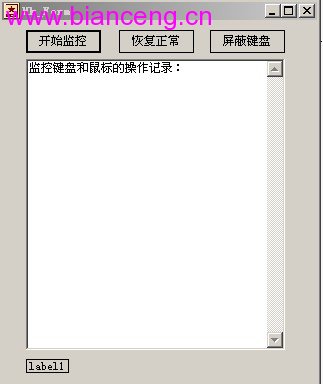運行界面如下:

二說明:
在C++中實現該功能十分簡單,也有很多經典例子可以實現,在C#中確有很多 問題會出現。
對於鉤子知識不太熟悉可以參考我轉載的另一篇文章: http://www.cnblogs.com/hocylan/articles/1033895.html[微軟HOOK技術專題]
三大概步驟
其實主要就是調用windows API
第一步:安裝鉤子:SetWindowsHookEx(WH_Codes idHook, HookProc lpfn,IntPtr pInstance, int threadId);
第二步:回調和處理CallNextHookEx(IntPtr pHookHandle, int nCode,Int32 wParam, IntPtr lParam);
第三步:完成普通的業務處理其它流程
將封裝的鉤子應用到系統中…….
private void start_Click(object sender, EventArgs e)
{hook_Main.InstallHook("1");}
private void stop_Click(object sender, EventArgs e)
{this.hook_Main.UnInstallHook();}
private void stopkeyboard_Click(object sender, EventArgs e)
{ hook_Main.InstallHook("2"); }
第四步:拆卸鉤子UnhookWindowsHookEx(IntPtr pHookHandle);
四 重要代碼和解釋:
*封裝的hook類:
using System;
using System.Windows.Forms;
using System.Runtime.InteropServices;//必須引用
using System.Reflection; //必須引用
namespace KeyboardHook
{
class Hocy_Hook
{
#region私有常量
///<summary>
///按鍵狀態數組
///</summary>
private readonly byte[] m_KeyState = new byte[ 256 ];
private string flags;
//flag=0 正常 flag=1 監控狀態 flag=2 屏蔽鍵盤//
#endregion私有常量
#region私有變量
///<summary>
///鼠標鉤子句柄
///</summary>
private IntPtr m_pMouseHook = IntPtr.Zero;
///<summary>
///鍵盤鉤子句柄
///</summary>
private IntPtr m_pKeyboardHook = IntPtr.Zero;
///<summary>
///鼠標鉤子委托實例
///</summary>
///<remarks>
///不要試圖省略此變量,否則將會導致
///激活CallbackOnCollectedDelegate 托管調試助手(MDA)。
///詳細請參見MSDN中關於CallbackOnCollectedDelegate 的描述
///</remarks>
private HookProc m_MouseHookProcedure;
///<summary>
///鍵盤鉤子委托實例
///</summary>
///<remarks>
///不要試圖省略此變量,否則將會導致
///激活CallbackOnCollectedDelegate 托管調試助手(MDA)。
///詳細請參見MSDN中關於CallbackOnCollectedDelegate 的描述
///</remarks>
private HookProc m_KeyboardHookProcedure;
// 添加
public event MouseEventHandler OnMouseActivity;
private const byte VK_SHIFT = 0x10 ;
private const byte VK_CAPITAL = 0x14;
private const byte VK_NUMLOCK = 0x90;
#endregion私有變量
#region事件定義
///<summary>
///鼠標更新事件
///</summary>
///<remarks>當鼠標移動或者滾輪滾動時觸發 </remarks>
public event MouseUpdateEventHandler OnMouseUpdate;
///<summary>
///按鍵按下事件
///</summary>
public event KeyEventHandler OnKeyDown;
///<summary>
///按鍵按下並釋放事件
///</summary>
public event KeyPressEventHandler OnKeyPress;
///<summary>
///按鍵釋放事件
///</summary>
public event KeyEventHandler OnKeyUp;
#endregion事件定義
#region私有方法
///<summary>
///鼠標鉤子處理函數
///</summary>
///<param name="nCode"></param>
///<param name="wParam"></param>
///<param name="lParam"></param>
///<returns>鼠標鉤子處理函數</returns>
private int MouseHookProc( int nCode, Int32 wParam, IntPtr lParam )
{
if ((nCode >= 0) && (OnMouseActivity != null))
{
//Marshall the data from callback.
MouseHookStruct mouseHookStruct = (MouseHookStruct) Marshal.PtrToStructure(lParam, typeof(MouseHookStruct));
//detect button clicked
MouseButtons button = MouseButtons.None;
short mouseDelta = 0;
switch (wParam)
{
case (int)WM_MOUSE.WM_LBUTTONDOWN:
//case WM_LBUTTONUP:
//case WM_LBUTTONDBLCLK:
button = MouseButtons.Left;
break;
case (int)WM_MOUSE.WM_RBUTTONDOWN:
//case WM_RBUTTONUP:
//case WM_RBUTTONDBLCLK:
button = MouseButtons.Right;
break;
case (int)WM_MOUSE.WM_MOUSEWHEEL:
//If the message is WM_MOUSEWHEEL, the high- order word of mouseData member is the wheel delta.
//One wheel click is defined as WHEEL_DELTA, which is 120.
//(value >> 16) & 0xffff; retrieves the high-order word from the given 32-bit value
mouseDelta = (short) ((mouseHookStruct.MouseData>> 16) & 0xffff);
//TODO: X BUTTONS (I havent them so was unable to test)
//If the message is WM_XBUTTONDOWN, WM_XBUTTONUP, WM_XBUTTONDBLCLK, WM_NCXBUTTONDOWN, WM_NCXBUTTONUP,
//or WM_NCXBUTTONDBLCLK, the high-order word specifies which X button was pressed or released,
//and the low-order word is reserved. This value can be one or more of the following values.
//Otherwise, mouseData is not used.
break;
}
//double clicks
int clickCount = 0;
if (button != MouseButtons.None)
if (wParam == (int)WM_MOUSE.WM_LBUTTONDBLCLK || wParam == (int)WM_MOUSE.WM_RBUTTONDBLCLK) clickCount = 2;
else clickCount = 1;
//generate event
MouseEventArgs e = new MouseEventArgs(
button,
clickCount,
mouseHookStruct.Point.X,
mouseHookStruct.Point.Y,
mouseDelta);
//raise it
OnMouseActivity(this, e);
}
//*
return Win32API.CallNextHookEx( this.m_pMouseHook, nCode, wParam, lParam );
}
///<summary>
///鍵盤鉤子處理函數
///</summary>
///<param name="nCode"></param>
///<param name="wParam"></param>
///<param name="lParam"></param>
///<returns></returns>
///<remarks></remarks>
private int KeyboardHookProc( int nCode, Int32 wParam, IntPtr lParam )
{
switch (flags)
{
case "2":
return 1;
break;
case "1":
break;
}
bool handled = false;
//it was ok and someone listens to events
if ((nCode >= 0) && (this.OnKeyDown != null || this.OnKeyUp!= null || this.OnKeyPress!= null))
{
//read structure KeyboardHookStruct at lParam
KeyboardHookStruct MyKeyboardHookStruct = (KeyboardHookStruct)Marshal.PtrToStructure(lParam, typeof (KeyboardHookStruct));
//raise KeyDown
if (this.OnKeyDown != null && (wParam == (int) WM_KEYBOARD.WM_KEYDOWN || wParam == (int)WM_KEYBOARD.WM_SYSKEYDOWN))
{
Keys keyData = (Keys) MyKeyboardHookStruct.VKCode;
KeyEventArgs e = new KeyEventArgs(keyData);
this.OnKeyDown(this, e);
handled = handled || e.Handled;
}
// raise KeyPress
if (this.OnKeyPress != null && wParam == (int)WM_KEYBOARD.WM_KEYDOWN)
{
bool isDownShift, isDownCapslock;
try
{
isDownShift = ((Win32API.GetKeyStates (VK_SHIFT) & 0x80) == 0x80 ? true : false);
isDownCapslock = (Win32API.GetKeyStates (VK_CAPITAL) != 0 ? true : false);
}
catch
{
isDownCapslock = false;
isDownShift= false;
}
byte[] keyState = new byte[256];
Win32API.GetKeyboardState(keyState);
byte[] inBuffer = new byte[2];
if (Win32API.ToAscii (MyKeyboardHookStruct.VKCode,
MyKeyboardHookStruct.ScanCode,
keyState,
inBuffer,
MyKeyboardHookStruct.Flags) == 1)
{
char key = (char)inBuffer[0];
if ((isDownCapslock ^ isDownShift) && Char.IsLetter(key)) key = Char.ToUpper(key);
KeyPressEventArgs e = new KeyPressEventArgs(key);
this.OnKeyPress(this, e);
handled = handled || e.Handled;
}
}
// raise KeyUp
if (this.OnKeyUp != null && (wParam == (int) WM_KEYBOARD.WM_KEYUP || wParam == (int)WM_KEYBOARD.WM_SYSKEYUP))
{
Keys keyData = (Keys) MyKeyboardHookStruct.VKCode;
KeyEventArgs e = new KeyEventArgs(keyData);
this.OnKeyUp(this, e);
handled = handled || e.Handled;
}
}
//if event handled in application do not handoff to other listeners
if (handled)
return 1;
else
return Win32API.CallNextHookEx(this.m_pKeyboardHook, nCode, wParam, lParam);
}
#endregion私有方法
#region公共方法
///<summary>
///安裝鉤子
///</summary>
///<returns></returns>
public bool InstallHook(string flagsinfo)
{
this.flags = flagsinfo;
IntPtr pInstance = Marshal.GetHINSTANCE(Assembly.GetExecutingAssembly ().ManifestModule);
//pInstance = (IntPtr)4194304;
//注意:很多時候得到的pInstanc無法安裝鉤子,請檢查值是否為 4194304,在應用程序中可以直接取得pinstance的
// IntPtr pInstanc2 = Marshal.GetHINSTANCE (Assembly.GetExecutingAssembly());
// Assembly.GetExecutingAssembly().GetModules()[0]
//安裝鼠標鉤子
if ( this.m_pMouseHook == IntPtr.Zero )
{
this.m_MouseHookProcedure = new HookProc( this.MouseHookProc );
this.m_pMouseHook = Win32API.SetWindowsHookEx( WH_Codes.WH_MOUSE_LL,this.m_MouseHookProcedure, pInstance, 0 );
// WH_Codes.WH_MOUSE_LL為全局鉤子即系統鉤子,否則應該為 WH_Codes.WH_KEYBOARD,即普通鉤子
if ( this.m_pMouseHook == IntPtr.Zero )
{
this.UnInstallHook();
return false;
}
}
if ( this.m_pKeyboardHook == IntPtr.Zero ) //安裝鍵盤鉤子
{
this.m_KeyboardHookProcedure = new HookProc( this.KeyboardHookProc );
// WH_Codes.WH_KEYBOARD_LL為全局鉤子即系統鉤子,否則 應該為WH_Codes.WH_KEYBOARD,即普通鉤子
this.m_pKeyboardHook = Win32API.SetWindowsHookEx( WH_Codes.WH_KEYBOARD_LL,this.m_KeyboardHookProcedure, pInstance, 0 );
if ( this.m_pKeyboardHook == IntPtr.Zero )
{
this.UnInstallHook();
return false;
}
}
return true;
}
///<summary>
///卸載鉤子
///</summary>
///<returns></returns>
public bool UnInstallHook()
{
bool result = true;
if ( this.m_pMouseHook != IntPtr.Zero )
{
result = ( Win32API.UnhookWindowsHookEx( this.m_pMouseHook ) && result );
this.m_pMouseHook = IntPtr.Zero;
}
if ( this.m_pKeyboardHook != IntPtr.Zero )
{
result = ( Win32API.UnhookWindowsHookEx( this.m_pKeyboardHook ) && result );
this.m_pKeyboardHook = IntPtr.Zero;
}
return result;
}
#endregion公共方法
#region構造函數
///<summary>
///鉤子類
///</summary>
///<remarks>本類僅僅簡單實現了WH_KEYBOARD_LL 以及 WH_MOUSE_LL </remarks>
public Hocy_Hook()
{
Win32API.GetKeyboardState( this.m_KeyState );
}
#endregion構造函數
}
}
下載源程序和運行程序